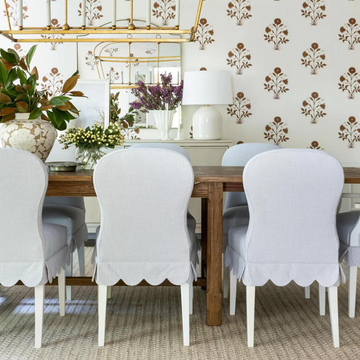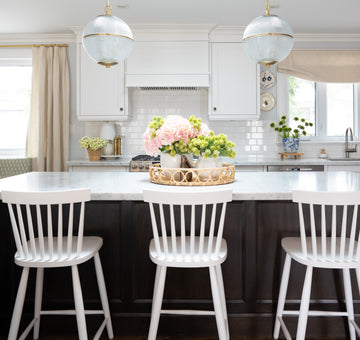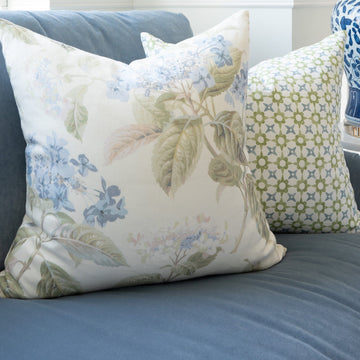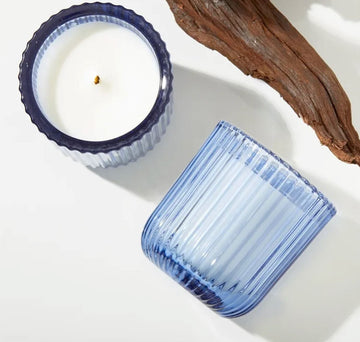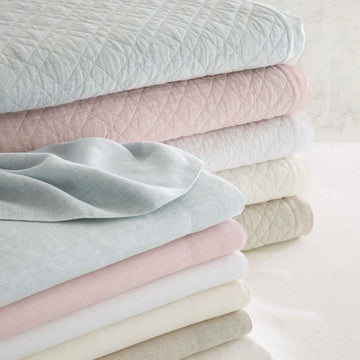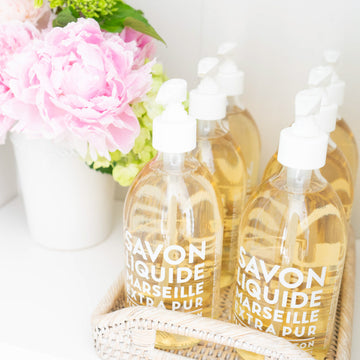The magic of spring gets us every time — that moment when the first buds peek out from the frozen ground is one of our favourite times of the year. And, our favourite way to capture that energy and excitement of new growth is to bring it inside with spring flowers.
Professional florist Emily Hall is the owner of Threads and Blooms, a boutique wedding florist in Ontario's Niagara region. We admire Emily for her loose and colourful aesthetic: Her approach to floral styling has a free-and-easy feel that dazzles for special events, and is perfectly unfussy for display at home. We asked her to show us her tricks for creating arrangements worthy of the season.
HELLO, READERS!
My name is Emily and I am the owner and florist at Threads & Blooms.
Bringing flowers inside is such a great way to infuse life and beauty into a space. Today I’m going to share some tips for making flowers, fresh and potted, look beautiful in your home!
Making a Garden-Style Flower Arrangement
Nothing brightens a room quite like a vase of freshly cut blooms. While it's perfectly lovely to fill a vase with a single-variety bunch of your favourite flower, it's so much fun to let your creativity run wild by putting together a colourful mixed arrangement. Assembling a statement-making bouquet of florals and greenery doesn't have to be complicated, either. Here, I'll break the process down into five easy steps.
Flowers & Photo by Emily Hall.
1. Pick Your Vase
If you are someone who loves to have flowers in your home, I definitely suggest owning a couple of vases that suit your style and you can use over and over. For this fresh flower arrangement I am using the Small Essential White Terracotta Pot from Rainsford Company. It has a 6” diameter opening and is about 4” tall which is a great size for making a traditional centrepiece arrangement like I am going to make here — it’s perfect for a dining or coffee table!
2. Prep Your Vase
Prepping your vase is an important step that will make creating a floral arrangement an easier and enjoyable process. Using tape (floral tape is best but regular tape works too), create a grid on the top of the vase like I have done in the image below. This grid is going to help keep your stems in place because it divides the top of the vase into smaller sections. If your vase is opaque, like the Essential Pot that I am using, you can even put a loosely formed ball of chicken wire inside the vase. The small sections of the chicken wire create more slots for the stems to slide into and further helps to secure them in place. With your mechanics in place, fill your vase with water!
Flowers & Photo by Emily Hall.
Flowers & Photo by Emily Hall.
3. Add Greenery First
If you are using greenery, add that in first. This will create the shape of your arrangement and also create a really good base for your flowers when you add them next. I like to use a combination of greenery varieties — a more bulky green with larger leaves is good to create a solid base (I used camellia) and then some delicate branches give the arrangement a really natural feel. Allow your greenery to spread in all directions from your vase. I like to use shorter pieces in the middle that sit close to the lip of the vase all the way around, and then let some longer pieces of greenery go off to the sides.
Flowers & Photo by Emily Hall.
4. Add Your Biggest Blooms
Start by adding your flowers with the largest blooms first and place them in such a way that they further define the shape created with the greenery. In my arrangement I started with the ranunculus. These larger flowers will be your focal blooms. I like to place one or two really close to the vase and then a couple that follow the longer greenery on the sides.
Flowers & Photo by Emily Hall.
5. Fill out the Arrangement
Next, fill out the arrangement with the rest of your blooms. For me that was daffodils, hyacinth, and tulips (spring faves!). With bloom placement, work down in terms of bloom size and finish with adding the smallest blooms last. I like this order because then it allows the smallest blooms to stand out in front of the others and add a really nice accent.
Flowers & Photo by Emily Hall.
STYLE TIP
Try adding your flowers in such a way that they are all on different ‘planes’ within the arrangement. I like to have some blooms very close in to the vase, some sticking out further than others, and some even right in front or right behind other blooms. Placing your flowers on different planes is what will make a really special arrangement that has that ‘freshly picked’ look!
Maintenance
Keep your arrangement fresh by topping up with new water daily. Every couple of days, carefully tip the vase (while holding the flowers in place) and replace the water entirely. In my opinion, flower food isn’t necessary but fresh water is a must! If you see that any particular stems are fading, take them out and give them a sharp, angled cut using pruning shears. With a mixed fresh floral arrangement, some blooms will die before others so I like to just remove those blooms as that happens so the overall arrangement still looks fresh. As your arrangement gets smaller in size from removing the dying blooms, I like to have a few smaller vases on hand so you can use the long lasting flowers to create smaller arrangements and enjoy your flowers for as long as possible. The Rattan Vase from Rainsford Company would be perfect for enjoying those last few blooms from your arrangement!
Making a Spring Bulb Planter
At this time of year potted bulbs are such a great way to welcome spring into your home. They are affordable and readily available and look beautiful when simply placed in a decorative pot. It is also really easy to repot a few bulb varieties together to create a beautiful spring planter and that’s what I’m going to share here.
Flowers & Photo by Emily Hall.
1. Choose Your Planter.
Like with vases for fresh flowers, I love to have a couple of planters that I can use throughout the year for seasonal potted plants. When dealing with potted plants, it is important that your planter has a drain hole for proper water drainage. I am using the large-sized Organic Tapered Pot from Rainsford Company. It has a beautiful ceramic finish and, with a 10” diameter, it is great size to make a mixed bulb planter.
2. Prep the Soil
Top up your planter with soil to start. If you, like me, love bringing plants into your house, having a small bag of potting soil on hand to use for projects like this is always helpful! In my case, the planter I am going to be potting the bulbs into is taller than the plastic pot that the bulbs come in. The end goal is to have the bulbs sit at the top of the planter so I am going to fill the planter about half way before getting started and placing any bulbs. Before potting, always make sure the soil of both your plants and the soil in your pot is well hydrated.
Flowers & Photo by Emily Hall.
3. Place Your Potted Plants
Remove your potted plants from their plastic pot and place them into your prepared planter. You can gently remove some of the extra soil that is around the bulbs and you can even separate bulbs if you want to position them individually (often a 4” potted plant like the ones I am working with will have 2-4 bulbs per pot). Once you have placed your bulbs where you would like them to be in your planter, fill in all the gaps with soil so that all bulbs are completely covered and compact the soil to make sure the bulbs are secure in place. You want the finished soil level just above the bulbs at the base of the stem.
Flowers & Photo by Emily Hall.
STYLE TIP
Adding a bit of moss on the top of the soil gives your planter such a nice and complete look. This works for smaller bulb arrangements, like this one, as well as for some humidity-loving houseplants, like ferns or myrtle topiaries. A small bag of natural, preserved moss (available at garden centres) is another product that I like to have on hand—it will make all your potted projects look more professional!
Maintenance
Bulbs like to have hydrated but not wet soil. For a thorough watering, I will take the planter right to the sink to water it through but allow all the water to drain fully out the bottom. At this time of year you can enjoy your spring bulb planters inside or outside - with cooler temps outside you will find them to be a bit longer lasting out there. I like to purchase potted plants when the bulbs are still closed and then you are able to enjoy them for about 2 weeks and appreciate the whole process while they open. When my bulbs are finished I am excited to use this Organic Tapered Pot for herbs — it will be such a lovely addition to a potted herb garden!
